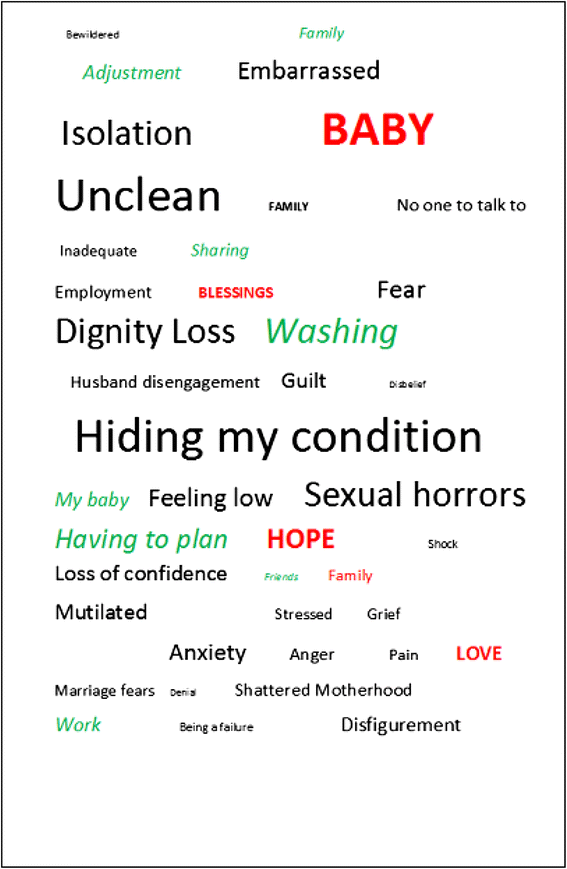The social, psychological, emotional morbidity and adjustment techniques for women with anal incontinence following Obstetric Anal Sphincter Injury: use of a word picture to identify a hidden syndrome
- PMID: 27654450
- PMCID: PMC5031357
- DOI: 10.1186/s12884-016-1065-y
The social, psychological, emotional morbidity and adjustment techniques for women with anal incontinence following Obstetric Anal Sphincter Injury: use of a word picture to identify a hidden syndrome
Abstract
Background: To identify the emotional, social and psychological consequences and recovery process of anal incontinence (AI) following obstetric anal sphincter injuries (OASIS) and explore if this can be identified as a recognisable syndrome with visual representation.
Methods: A qualitative approach was adopted for this study. Data derived from case studies (n = 81) and interviews (n = 14) with women with AI after OASIS was used to identify the emotional, social and psychological consequences of AI after OASIS. Keywords and synonyms were extracted and the power of these statements displayed as a 'word picture'. The validity and authenticity of the word picture was then assessed by: a questionnaire sent to a group of mothers who had experienced this condition (n = 16); a focus group attended by mothers (n = 14) and supported by health professionals (n = 6) and via interviews with health professionals (n = 12) who were involved with helping mothers with AI following OASIS.
Results: Women with AI resulting from OASIS have a specific syndrome - the 'OASIS Syndrome' - which we have uniquely visualised as a 'word picture'. They feel unclean which results in dignity loss, psychosexual morbidity, isolation, embarrassment, guilt, fear, grief, feeling low, anxiety, loss of confidence, a feeling of having been mutilated and a compromised role as a mother. Coping relies on repetitive washing (which may become a ritual), planning daily activities around toiletry needs, sharing, family support, employment if possible and attention to the baby. Recovery and healing is through care of the child and hope generated by love within the family.
Conclusions: This study has identified a previously unrecognised 'OASIS Syndrome' and, by way of a new and unique 'word picture', revealed a hidden condition. There should be greater awareness by the public and profession about the 'OASIS Syndrome' and a mechanism for early identification of the condition and referral for management. This, if successful, would overcome the barrier of silence which surrounds this currently unspoken taboo.
Keywords: Anal incontinence; Morbidity; OASIS; Obstetric anal sphincter injury; Psychological trauma.
Figures
References
-
- Daly JO, Sultan AH, Van Delft KW, Thakar R. Outcome of childbirth after previous obstetric anal sphincter injury. International urogynecology journal. London: Springer London Ltd; 2013. Vol. 24, pp. S69–S70.
-
- Brown S, Gartland D, Perlen S, et al. Consultation about urinary and faecal incontinence in the year after childbirth: a cohort study. Br J. Obstet. Gynae. 2014 - PubMed
Grants and funding
LinkOut - more resources
Full Text Sources
Other Literature Sources



